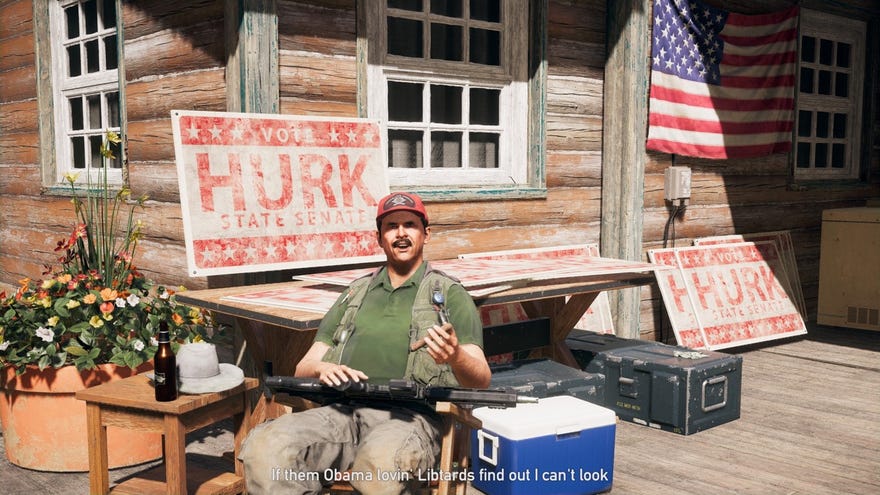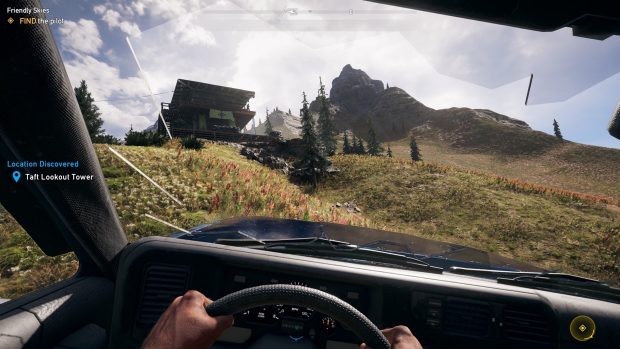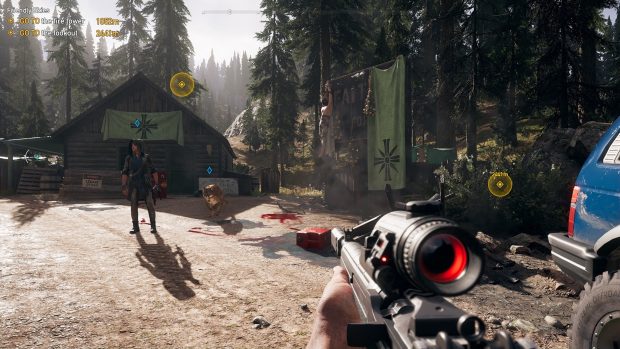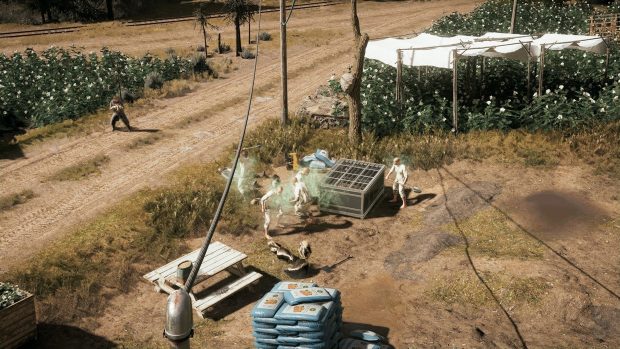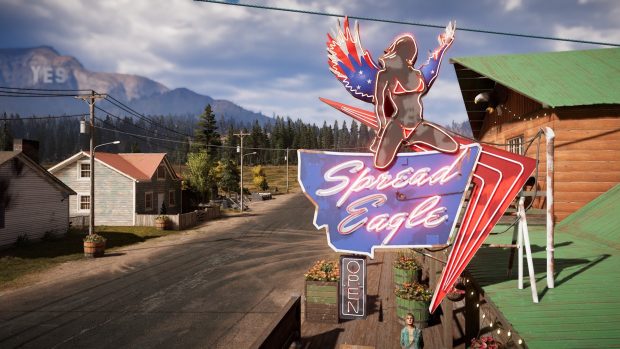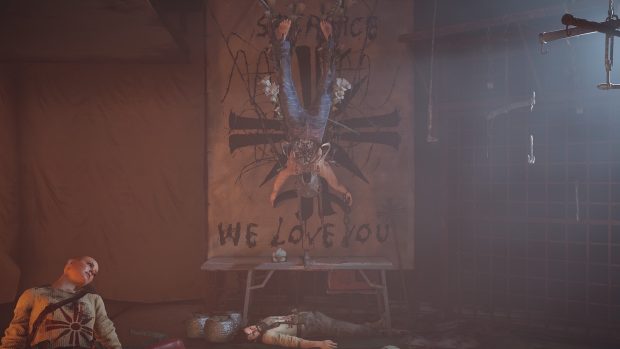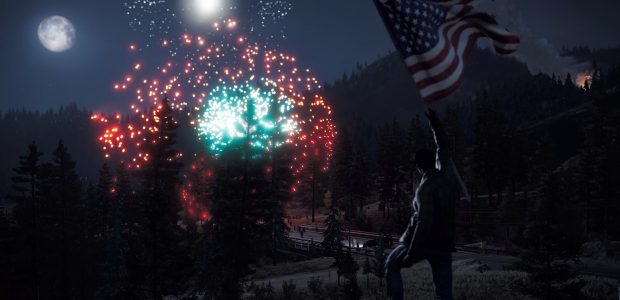Wot I Think: Far Cry 5
Freedom, at a price
Ah, a new Far Cry has appeared! Having torn up the Himalayas, Polynesia, Central Africa and The Past, in Far Cry 5 Ubisoft’s lidlessly searing eye for endless open-world violence has turned to the USA. Specifically, we're in Montana, where Ubisoft have conjured a new set of colourfully monologuing nemeses who toy with you as they enact their Bad Plans while you try to ignore them so you can get on with the important business of hanging out with animal pals. Which particular brand of environment and Kurtz-like do we get this time? Let’s find out.
Since Far Cry’s baddies are so often sculpted by their settings, let's start with Montana, which is the series’ most authentic location yet. While Hope County’s square miles of rolling pasture, small towns, sun-shafted forests, trailer parks, wide rivers and crystal creeks, summer camps and soaring mountains are fictional, they’re very specific constructs. It's a place of archetypes, even stereotypes, but they're closely observed and realised. It’s earthy and proud, home to sport hunters and survivalists, Republicans and farmers, and just like the real Montana, it’s beautiful.
Now, though, it’s been taken over by a preacher called Joseph Seed, who is forcefully converting its people to his cause, a cult called Eden’s Gate. He and his three sub-bosses look like alt-right hipsters, all man buns, well-groomed beards, tattoos and artfully torn gauzy dresses, but their cultist hordes wear long leather coats and bandoliers, their beards are massive and unkempt, and they string up bodies upside down on signboards so you know they mean business. And like Far Cry 3’s Vaas, Seed delivers his long prophetic speeches right into the camera with a lot of eye contact, so you know he means business too. But he’s a lot more serious than Vaas. Played by Nic Healey with quiet messianic verve, he’s sinister and powerful, and no fun at all.
And yet the wider game knows, just as 4 did, that Far Cry at its best is a playground for fun. It took about 45 minutes from the start before I was flying a helicopter. The parachute costs one Perk point, which took far less time. The wingsuit is four Perk points, which wouldn’t have taken much longer if it was my priority. Far Cry 5 is very much a ‘play it your way’ game, and it means business. The Perk system is one of many bits of Far Cry cruft that this new game has tidied up and reorganised.
Rather than through earning XP, you get Perk points by completing challenges, such as skinning bears, flamethrowing perps, catching a nice fish, or finding outdoor recreation magazines that are scattered around the world, and since most Perks aren’t arranged on skill trees, you’re free to focus your abilities on your playstyle. What’s more, many Perks pull through to Arcade mode, which gives you the chance to make maps and gametypes of your own with assets pulled from across the Ubiverse. It’s a staple of the series, but in giving access via arcade machines scattered across the world, it has new focus here, and its promise will be proven over the coming weeks.
The famous big change to the core game, though, is that you don’t have to climb towers to open up the map, something it pointedly illustrates by making you climb an extra high tower and then having Dutch, your survivalist bunker-dwelling radio chum radio, “I know what you’re thinking, and no, I’m not asking you to climb radio towers all over the county.” Good one, Far Cry 5. Instead, you fill in the map by simply going places, or by talking to NPCs with a map symbol above their head to add specific points of interest to it. The map, by the way, is wonderful, presented in full 3D so not only can you pan, zoom and rotate around it, but it’s also very easy to navigate because it looks like the world itself, and it doesn’t present the usual Ubisoft riot of icons to clear, instead delegating #content to a quest list on another screen.
Overall, Far Cry 5’s progression systems are dialled down, quieter; even its UI is designed to fade out so it doesn’t clutter your view. While there’s a wide array of wildlife to shoot, you don’t have to hunt it in order to craft your gear, as you did in previous games. You simply sell skins and fish you catch, and invest your money in vehicles and guns and their upgrades. It’s all very open; the one element that only gradually unlocks as you complete the campaign is higher tiers of guns and vehicles, but even then, you’re well outfitted simply by upgrading the early guns and buying the relevant perks. Far Cry 5 is very keen not to get in the way.
Until, that is, you try to get from one place to another. Which, uh, is a good deal of the game. I grumbled in my Review in Progress about the way you’re constantly bombarded with ’Peggies’, the name your Resistance friends have given Eden’s Gate cultists. Driving along any road is an exercise in being shot at and distracted by enemy vehicles and patrols every few seconds. Try to walk anywhere before you’ve upgraded your health and you’ll often die several times on the journey. I found things settled as I got more powerful and understood what it was worth getting out of the car to deal with, but I also found myself turning to the fast travel option more frequently than I’d like. Then again, when I sparked up my old Far Cry 4 save I found Kyrat surprisingly busy, and it had those bloody eagles, too. And we all remember the pain of Far Cry 2’s respawning outposts. Far Cry always did put a lot of bodies in front of anyone just trying to get around, but here the volume seems pitched a little too high.
Dealing with all of those interruptions isn't quite as grim as it might be thanks to combat design that I reckon is the best in the series. Over the 15 hours it took me to complete the campaign, most of the outposts and other bits and pieces, I killed 1529 Peggies, and the only dull fights were the scrappy little emergent ones which didn’t last long enough for me to get stuck into. The shooting feels responsive and precise in a way that the series hasn’t achieved before, the environments constantly providing fun options and opportunities. In particular, the outposts encompass a fine range of industrial halls, precipitous towers, cluttered yards and domestic houses, their twists and turns complementing the AI’s focus on dynamic movement. Its stealth is finely tuned, too, so that your cover is quick to blow but, in turn, it’s usually easy enough to reposition and leave enemies confused. While death comes easily, I feel encounters play out on my terms.
Further supporting Far Cry 5’s sense of freedom is its Gun for Hire system, which lets you choose an AI partner to play alongside. There are randoms and you can also unlock a roster of nine preset characters which each focus on a different play style. There’s Cheeseburger the bear, which aggros enemies with abandon, Jess Black the stealthy archer, the RPG-toting Hurk (yes, the series stalwart), Boomer the enemy-sighting dog, and Nick Rye, who pilots a seaplane. You can command them to move to locations and to attack targets (Nick Rye will strafe and lay down exasperatingly inaccurate bombs after agonising delays - he’s my favourite), and they’ll inform your approach to any situation, bringing in extra ordnance and tactical choices. They’re useful and good to have around, particularly as they’ll revive you if they can get to you before you bleed out, but fair warning: they’ll also block doorways, and there was that time a helicopter wouldn’t spawn from the shop because Grace Armstrong, the sniper, was standing on the helipad.
The story missions largely do a good job of mixing up self-initiated encounters with assaults on heavily defended buildings, defending positions against waves of attackers, or destroying caches of Bliss, a hallucinogenic drug being manufactured by the cult to control the people. Few are anything you haven’t done before in a Far Cry, but they’re well-staged and good at imposing frantic situations where you're not entirely in control. Mixed with other pursuits, such as locating prepper stashes - an excellent series of well-rewarded environmental puzzles - they’re good changes of pace.
The reason why you’re doing all of this is to earn Resistance Points in each of the map’s three regions to fill their individual Resistance gauges. Once they're full, you face the boss of that region. In the north there’s the Nazi-ish strong-shall-survive Jacob, Faith the lying Bliss-peddler in the east, and in the west John, who likes carving GLUTTONY on people’s chests before tearing their skin off. Resistance is essentially a notoriety system which leads Eden’s Gate into throwing more and more at you, so that at the upper end a plane hunts you, a constant airborne threat which adds an extra level of effort to travel the world. What’s more, crossing Resistance thresholds will pull you into story missions with the region’s boss, part of an arc that plays out across the region as you get to know the key friendly NPCs and become embroiled in their own stories.
The way the game initiates these missions is strange, framed as the boss sending a crack squad to hunt you down, and that means you might be in the middle of a conversation with an NPC and suddenly find your vision blurring as you fall into a very contrived scenario that you’ll need to complete to return to your game. The first time it happened to me I’d just crashed my helicopter and found myself being brought before John with no idea how I’d triggered the encounter. These sequences service the story and its antagonists’ gravitas, I suppose, but in a game otherwise so keen to get out of your way they feel jarring.
And that’s especially true because the story that these encounters kept dragging me to failed to convince me. Ubisoft has made many specific and portentous choices for Far Cry 5’s setting and setup, from the socio-political landscape of contemporary Montana to the dynamics of personality-driven cults, and it fails to resolve any of them. Rather than examine how normal people might be enveloped into violent and sadistic cults, Eden’s Gate is instead simply a mechanism which provides an anonymous evil to shoot at and also zombies, the Bliss-addled Angels. Its leaders emptily question your attempts to stop them, asking in their frequent crazy monologues, “But what if we’re right???” And then you remember they have headless bodies strung outside their bunker. Nope, they’re pretty straightforward evil.
The non-cult people of Hope County, meanwhile, are more fleshed out, but as well performed as they are, they’re not subtle. They’re crusty farmers, corrupt Republicans, survivalist veterans and brassy working class. On one hand, Montana is drawn as a homeland of the right wing with the air of the ridiculous about it, and on the other, their individualist beliefs, particularly the gun rights so many of them vocally support, have enabled them to resist Eden’s Gate. You take missions from an NPC who is torturing a cultist. Conversations acknowledge this might not be ideal, but the game leaves the issue hanging.
Ubisoft weren't predicting the rise of Trump when they started developing Far Cry 5, or the changing social and political landscape in America, but the game responds directly to current events with the odd one-liner, such as in mission titles like ‘Make Hope Great Again’ (in which you have to kill some cultists because they won’t vote for a Republican NPC gunning for senate). Far Cry 5 deals with its relationship with reality awkwardly, its adjacency to current affairs in the US continually jutting into what could, and probably should, be the more uncomplicated fun the rest of the game works so hard to enable. The fundamental problem is that the game doesn’t obey the dramatic principle of Chekov’s gun. Whatever your personal stance on these issues, it’s distracting for the game to raise them and then cast them aside without due care.
Far Cry 5 is frustratingly uneven as a whole. From minute to minute its combat systems are the best in the series, and its vehicles handle better than those in previous games as well. Its landscapes are a delight, their details rich and worth exploring, and you get to develop your playstyle and objectives on your own terms. Until something gets in the way. It wants you to enjoy all of the freedom it offers until, through its systems, characters or story, an interruption arrives. It's the land of the free, but that freedom only goes so far.
Far Cry 5 is out now and is available on Steam and UPlay for £49.99/€59.99/$59.99.
